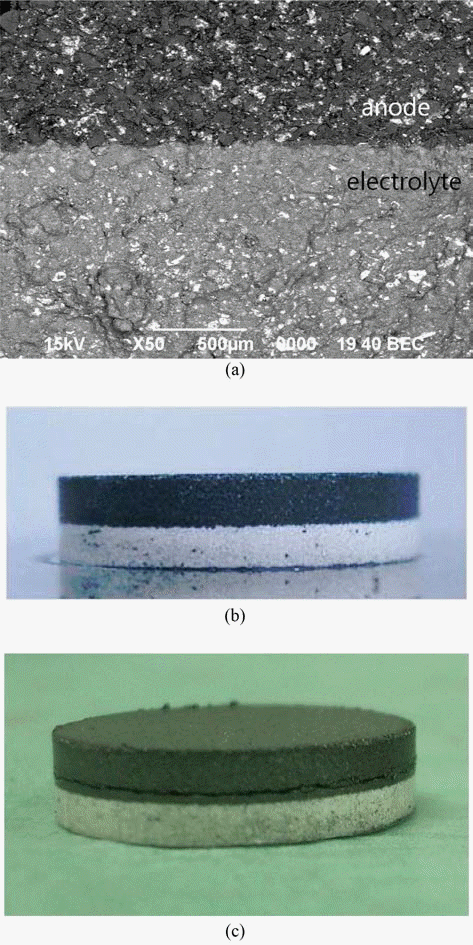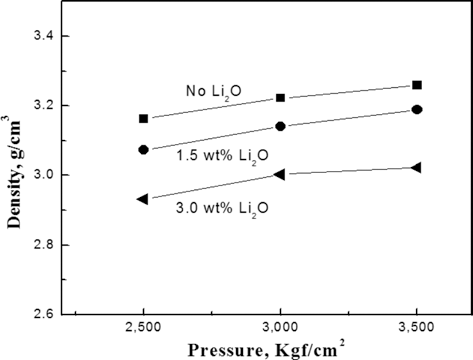Search
- Page Path
- HOME > Search
- [Korean]
- Effects of Particle Size and Binder Phase Addition on Formability of Li-Si Alloy Powder for Thermal Battery Anode
- Sung-Soo Ryu, Hui-Sik Kim, Seongwon Kim, Hyung-Tae Kim, Hae-Won Cheong, Sung-Min Lee
- J Korean Powder Metall Inst. 2014;21(5):331-337. Published online October 1, 2014
- DOI: https://doi.org/10.4150/KPMI.2014.21.5.331

- 585 View
- 8 Download
-
 Abstract
Abstract
 PDF
PDF The effects of particle size of Li-Si alloy and LiCl-KCl addition as a binder phase for raw material of anode were investigated on the formability of the thermal battery anode. The formability was evaluated with respect to filling density, tap density, compaction density, spring-back and compressive strength. With increasing particle size of Li-Si alloy powder, densities increased while spring-back and compressive strength decreased. Since the small spring-back is beneficial to avoiding breakage of pressed compacts, larger particles might be more suitable for anode forming. The increasing amount of LiCl-KCl binder phase contributed to reducing spring-back, improving the formability of anode powder too. The control of particle size also seems to be helpful to get double pressed pellets, which consisted of two layer of anode and electrolyte.
- [Korean]
- Effects of Li2O Addition and Heat-Treatment on Formability of FeS2 Powder for Cathode of Thermal Battery
- Sung-Soo Ryu, Won-Jin Lee, Seongwon Kim, Hae-Won Cheong, Sung-Baek Cho, Seung-Ho Kang, Sung-Min Lee
- J Korean Powder Metall Inst. 2014;21(3):185-190. Published online June 1, 2014
- DOI: https://doi.org/10.4150/KPMI.2014.21.3.185

- 560 View
- 4 Download
- 1 Citations
-
 Abstract
Abstract
 PDF
PDF FeS2 has been widely used for cathode materials in thermal battery because of its high stability and current capability at high operation temperature. Salts such as a LiCl-KCl were added as a binder for improving electrical performance and formability of FeS2 cathode powder. In this study, the effects of the addition of Li2O in LiCl-KCl binder on the formability of FeS2 powder compact were investigated. With the increasing amount of Li2O addition to LiCl-KCl binder salts, the strength of the pressed compacts increased considerably when the powder mixture were pre-heat-treated above 350°C. The heat-treatment resulted in promoting the coating coverage of FeS2 particles by the salts as Li2O was added. The observed coating as Li2O addition might be attributed to the enhanced wettability of the salt rather than its reduced melting temperature. The high strength of compacts by the Li2O addition and pre-heat-treatment could improve the formability of FeS2 raw materials.
-
Citations
Citations to this article as recorded by- Effects of Particle Size and Binder Phase Addition on Formability of Li-Si Alloy Powder for Thermal Battery Anode
Sung-Soo Ryu, Hui-Sik Kim, Seongwon Kim, Hyung-Tae Kim, Hae-Won Cheong, Sung-Min Lee
Journal of Korean Powder Metallurgy Institute.2014; 21(5): 331. CrossRef
- Effects of Particle Size and Binder Phase Addition on Formability of Li-Si Alloy Powder for Thermal Battery Anode
TOP
 KPMI
KPMI


 First
First Prev
Prev


